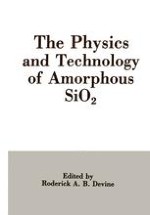1988 | OriginalPaper | Buchkapitel
Thermal Oxidation of Silicon
verfasst von : A. G. Revesz, B. J. Mrstik, H. L. Hughes
Erschienen in: The Physics and Technology of Amorphous SiO2
Verlag: Springer US
Enthalten in: Professional Book Archive
Aktivieren Sie unsere intelligente Suche, um passende Fachinhalte oder Patente zu finden.
Wählen Sie Textabschnitte aus um mit Künstlicher Intelligenz passenden Patente zu finden. powered by
Markieren Sie Textabschnitte, um KI-gestützt weitere passende Inhalte zu finden. powered by
Thermal oxidation of silicon results in the formation of a non-crystalline (nc) SiO2 film through which the oxidizing species, oxygen or OH, diffuses. A key feature of nc-SiO2 is the wide range of Si-O-Si bond angles (120°-l80°) associated with a very small variation (≈0.1 eV) in the Si-O bond energy. The Si substrate influences the structure of the oxide by affecting the short-range-order (SRO) of the (newly formed) oxide at the interface. Thus the structure of the as-grown oxide resembles that of some high density polymorph of SiO2; this effect is labelled quasi-expitaxy. As further growth occurs at the interface, pushing away the previously grown oxide, the structure then relaxes to more closely resemble that of vitreous SiO2. This relaxation process is similar to that which occurs after pressure compaction of vitreous SiO2, as indicated by measurements of the changes in the index of refraction and density of the oxide. This process is essentially a pseudo-polymorphic transformation of the oxide structure in the course of which the SRO of the oxide mimics that of various crystalline SiO2 polymorphs and results in substantial accomodation of the large volume expansion (≈126 %) associated with the transfer of Si atoms from the substrate to the oxide. This transformation differs from viscous flow, which has often been used to account for the relaxation of stress in the oxide, primarily in that it does not require the breaking of bonds, as does the viscous flow model. We point out several difficulties of the viscous flow model in explaining experimental observations.Because the transformation does not involve breaking bonds, in dry oxides some remnants of the originial quasi-epitaxial layer remain in the oxide in the form of intrinsic structural channels which are oriented preferentially normal to the interface. Because transport of O2 molecules along these channels is easier than through the bulk of the oxide, they affect the oxidation kinetics of the Si. Hence, the oxidation kinetics in dry O2 is described in terms of two transport processes; one which describes the normal random-walk interactive diffusion through the oxide and depends on the oxide thickness, and one which describes a non-interactive oxygen transport through the structural channels and which is relatively independent of the thickness of the oxide. The random-walk diffusion is associated with a limited exchange process between O2 molecules in solubility sites and network O atoms. This interaction has been observed by 18O tracer experiments as affecting mostly the outer surface region of the Sil6O2 films. Such a model for the oxidation kinetics and mechanism produces very good agreement with experimental growth rate data over a wide range of oxide thicknesses without assuming any special mechanism for the initial “fast growth” regime and/or the oxygen exchange process.
